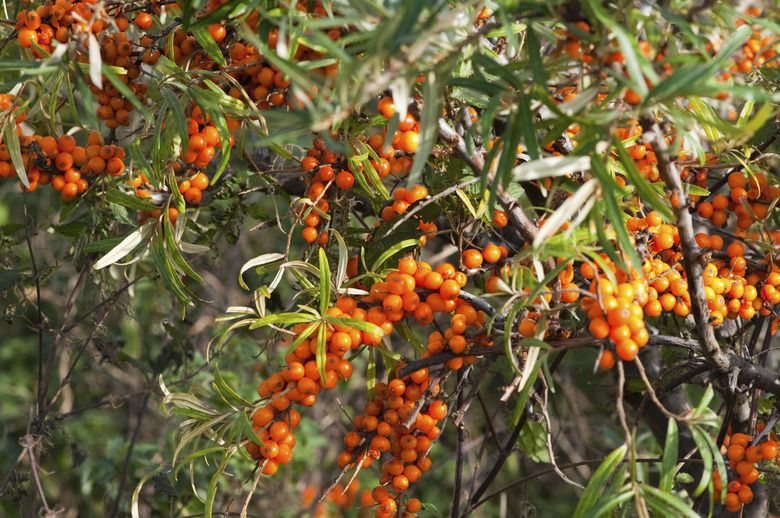Buckthorn Tree Facts
Buckthorns are deciduous bushes or small trees in the buckthorn family (Rhamnaceae), and several species are native to North America while others originated in Europe, Asia, Eurasia and/or Africa. The name "buckthorn" comes from the non-native species, which have sharp, thornlike tips at branch ends.
Buckthorns are deciduous bushes or small trees in the buckthorn family (Rhamnaceae), and several species are native to North America while others originated in Europe, Asia, Eurasia and/or Africa. The name "buckthorn" comes from the non-native species, which have sharp, thornlike tips at branch ends. All buckthorns are either male or female and have glossy, dark-green leaves and black berries. Species native to the United States have been eclipsed by introduced species, which have become invasive throughout much of the country.
Invasive vs. Non-Invasive Nature
Buckthorns are used as garden subjects, providing rich, green foliage for garden backdrops and fruit for wildlife. That is why two buckthorn species — common buckthorn (Rhamnus cathartica) and glossy or alder buckthorn (Frangula alnus and Rhamnus frangula) — were introduced to North America in the 1800s, but they have become invasive. Common buckthorn, which is hardy in U.S. Department of Agriculture plant hardiness zones 3 through 7, has spread to all except 14 U.S. states as well as to Canada. Glossy buckthorn, hardy in USDA zones 3 through 7, hasn't spread as widely. Native buckthorns aren't invasive but aren't widely available as horticultural subjects. If you want to grow them, then contact plant nurseries that specialize in native plants to find species suitable for your area.
- Buckthorns are deciduous bushes or small trees in the buckthorn family (Rhamnaceae), and several species are native to North America while others originated in Europe, Asia, Eurasia and/or Africa.
Non-Invasive Species
Of the native buckthorn species that grow across the United States, perhaps the one most available for garden use is Carolina buckthorn (Rhamnus caroliniana), which doesn't have thorns or spines and is hardy in USDA zones 5 through 9. It grows from New York south to Florida and then west to Texas and Nebraska. It reaches 10 to 15 feet tall and wide, and its green berries turn red then black. An introduced species, Italian buckthorn (Rhamnus alaternus) from the Mediterranean area, also isn't invasive. Hardy in USDA zones 7 through 10, it reaches 20 feet tall and is suitable for screening or as a hedge. Its small, black berries are poisonous.
Invasive Species
Common buckthorn in particular is considered extremely invasive. One reason it spreads is because birds and other wildlife eat its fruits and deposit the fruits' seeds in their droppings. The berries contain cathartic chemicals which act as a laxative, and that effect helps to spread the seeds quickly. Don't eat the bitter fruits, and keep children from eating them; parts of common buckthorn and other buckthorns may be poisonous. Some other reasons for common buckthorn's invasive nature lie in how it grows. Its leaves emerge early and stay on late, and its branches are dense and thickly leaved. So it keeps the ground shaded, which discourages other plant growth. Don't plant common buckthorn or glossy buckthorn, and remove them if they start growing in your yard.
- Of the native buckthorn species that grow across the United States, perhaps the one most available for garden use is Carolina buckthorn (Rhamnus caroliniana), which doesn't have thorns or spines and is hardy in USDA zones 5 through 9.
Control Measures
The best way to keep common buckthorn and glossy buckthorn out of your yard is to inspect your yard frequently for young specimens of them. When buckthorns have invaded an area recently, mechanical control of them is an option. Pull out the trees or repeatedly cut them back to eradicate small populations of them. The young plants are relatively simple to pull up when the soil is wet. Concentrate on getting rid of female buckthorns so they don't produce seeds that fall into the soil. Well-established buckthorn populations are difficult to eradicate.
References
- Columbia University: Introduced Species Summary Project — Common Buckthorn (Rhamnus Cathartica L.)
- Plants for a Future: Rhamnus Cathartica
- Plants for a Future: Frangula Alnus
- Missouri Botanical Garden: Rhamnus Caroliniana
- California Polytechnic State University, Urban Forest Ecosystems Institute: Italian Buckthorn, Rhamnus Alaternus
- Invasive Species Council of Manitoba and Manitoba Purple Loosestrife Project: Common Buckthorn and Glossy Buckthorn
- Trees, Shrubs and Vines for Attracting Birds; Richard M. DeGraaf
